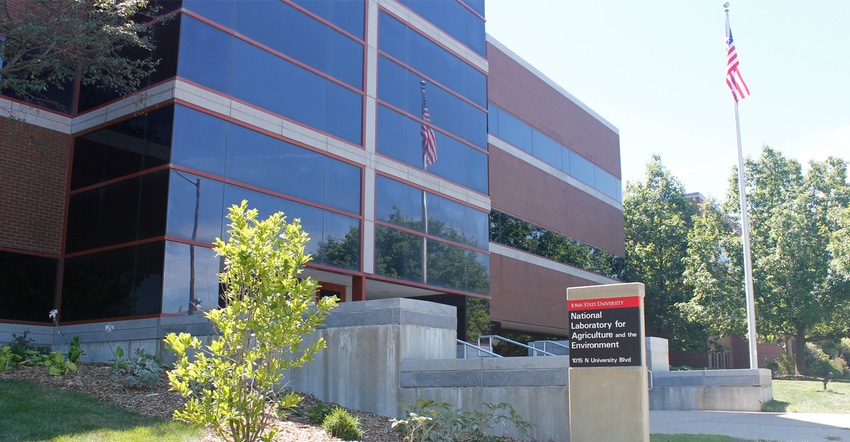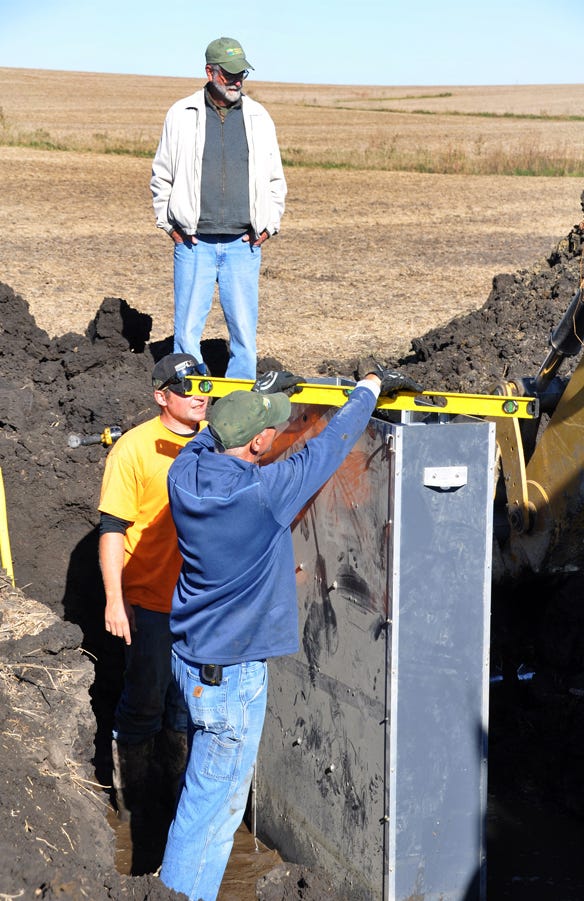September 16, 2020

A collaborative partnership between researchers with USDA’s Agricultural Research Service and Iowa State University has produced a string of notable water quality studies that have influenced conservation research and practice nationwide.
The relationship has leveraged multiple benefits. ARS scientists choose projects that offer opportunities linked to their national program goals and gain an eager cadre of graduate students to support federal research. For the university, the presence of ARS’ National Laboratory for Agriculture and the Environment (formerly known as the Soil Tilth Lab) has attracted additional resources and attention, often providing a national stage for local innovation.
From assessing the late-spring nitrogen test to developing the new Agricultural Conservation Planning Framework, their shared mission has been to improve water quality through understanding and engagement.
Nutrients the issue
USDA scientist Dan Jaynes arrived in Ames in 1990 to study pesticides in Iowa’s water under the new Management Systems Evaluation Area program (MSEA). The federal water quality initiative put Walnut Creek, located south of Ames, on the national map and helped introduce the watershed approach.
 CLEANER WATER: ARS scientist Dan Jaynes, now retired, watches an installation of a water control structure for a saturated riparian buffer in Story County, Iowa.
CLEANER WATER: ARS scientist Dan Jaynes, now retired, watches an installation of a water control structure for a saturated riparian buffer in Story County, Iowa.

The MSEA team’s monitoring soon convinced them that pesticides were less of a problem than the nitrogen and phosphorus showing up at concerning levels. That began the long effort to reduce nutrient pollution.
Working with the late ISU agronomist Alfred Blackmer, one of Jaynes’ early projects was to help test the late-spring soil nitrate test’s effectiveness as a tool to estimate soil nitrogen availability to crops. Their goal was to help farmers better tailor fertilizer use to reduce nitrogen loss. They found the tool worked well, reducing nitrate leaving a 1,000-acre watershed by an estimated 30%. Unfortunately, practical issues with the regular soil sampling and timely management it required discouraged widespread adoption.
Growth of precision farming
Another drainage research project in Boone County helped spur early development of precision farming. The research team included ISU ag engineer Jim Baker, now retired, and ARS colleagues, Doug Karlen, Tom Kaspar and Tom Colvin, also retired. They set up 224 microplots where they intensively measured water quality, soil and landscape position, and recorded the correlation with yield. Their effort to identify the economic optimal return to nitrogen in the different landscape positions yielded some surprises.
“Our findings were the opposite of what was often considered common wisdom,” Jaynes says. “The returns on different plots varied widely from year to year, depending primarily on rainfall, but overall, the low spots and potholes showed the lowest returns from fertilizer applications. The low spots could deliver high production, but they needed the least nitrogen to perform.”
Award-winning drainage research
Jaynes, Kaspar, ARS research microbiologist Tom Moorman and other colleagues contributed to early work on cover crops and experimented with drainage modifications that could cut nutrient loss while protecting crop yields. That work, part of a North Central Extension Research group, was honored by USDA in 2018 with a national Excellence in Multistate Research Award, shared with ISU faculty members Rameshwar Kanwar, a Charles F. Curtiss Distinguished Professor in ag and biosystems engineering, and Matt Helmers, professor of ag and biosystems engineering. Helmers is now director of the Iowa Nutrient Research Center.
Development of saturated riparian buffers has been a favorite project of Jaynes’ career. That innovation started with a brainstorm he and ISU Professor Tom Isenhart, natural resource ecology and management, developed into a nitrogen-reduction practice with multiple benefits.
“It was a pretty simple idea that is fairly inexpensive to install, requires little maintenance — and it works even better than we thought it would,” Jaynes notes. The work to develop and pilot the practice received early help from ISU’s Leopold Center for Sustainable Agriculture and advances with support from the Iowa Nutrient Research Center at Iowa State.
ARS’ Moorman continues to be involved with Isenhart and others to refine saturated buffer design so the technology can be applied more widely. For example, one of his projects is to locate saturated buffers along ag drainage district tile drains and study the results.
Moorman has also been part of the ARS-CALS team developing wood chip bioreactors as a conservation practice. An expert in the ecology of denitrifying bacteria, he studies the microbes in the wood chips, how they do their work and what kind of byproducts are released in the process. With ISU ag and biosystems engineering researchers Michelle Soupir, Adina Howe and others, they are experimenting with bioreactor variations, such as using corn cobs for a carbon source, that could make the systems cheaper or possibly more effective at reducing nitrogen pollution.
Teamwork for science
Research soil scientist John Kovar started his work with ARS while studying how poultry litter applied to fields in Louisiana impacted water quality. After moving to the lab in Iowa, he used that background to help the state develop a phosphorus index to guide fertilizer and manure management. “That project involved a large group of stakeholders, including agencies, commodity groups and farmers. They wanted something that would work – and could be broadly implemented, and it’s still being used 20 years later,” Kovar says.
Early on, he also served on the Leopold Center’s issue teams for agroecology and livestock management that helped identify the water quality benefits of managed grazing systems. More recently, his research has identified a larger-than-expected influence of streambank erosion on water quality. The work to track phosphorus movement through the landscape and understand how to stem its loss from sediments built up in stream banks and beds continues with CALS researchers including professors Isenhart and Richard Schultz, natural resource ecology and management, and Michael Thompson, agronomy, along with Keith Schilling of the Iowa Geological Survey.
They have all been part of the team assessing the science behind the Iowa Nutrient Reduction Strategy, which Kovar considers one of his more impactful collaborations.
“That was and continues to be a big effort with a lot of scientists and organizations involved, including commodity groups and the Iowa Agribusiness Association. Our work extends beyond Iowa and feeds into larger regional and national efforts to stem the nutrient pollution that feeds Gulf hypoxia,” Kovar says. “Because farmers and landowners were represented from the beginning, I think they trust what’s happening and have a stake in seeing progress.”
The science team continues to meet to consider how science can provide a sound basis for engagement and implementation, with leadership from ISU’s Iowa Nutrient Research Center.
New watershed tool helpful
A new tool the researchers are relying on, designed to help marry science and practice, is the Agricultural Conservation Planning Framework. Mark Tomer, a soil scientist with USDA ARS, has spent much of the last decade developing and refining the ACPF, which he calls “our first steps towards artificial intelligence for watershed planning.”
 NEW TOOLS: Along Beaver Creek in central Iowa, ARS soil scientist Mark Tomer and research technician Sarah Porter review a map showing results from using a tool set analyzing watershed data.
NEW TOOLS: Along Beaver Creek in central Iowa, ARS soil scientist Mark Tomer and research technician Sarah Porter review a map showing results from using a tool set analyzing watershed data.

Unveiled in 2018, ACPF 3.0 analyzes the latest geographic information system and research data to optimize placement of conservation practices. The framework relies on three main components: a planning approach aimed to enhance conservation decision-making, a set of detailed watershed databases and a GIS mapping toolbox. The toolbox analyzes the watershed data to propose landscape locations where conservation practices could be placed. The results help conservation planners and farmers visualize and prioritize choices to implement practices.
Farmers have also been involved at every stage in planning and testing, along with multiple federal and state partners including Iowa State University and ISU Extension. “One of the goals of the ACPF is to engage producers and encourage their participation in planning,” Tomer says. “It was built with their help, and their engagement is absolutely critical to its usefulness.
“Maybe our most important lesson learned over the years has been that science doesn’t make a difference by itself,” he adds. “The best tools are ineffective without a long-term commitment to adopt and maintain practices, and that requires support from landowners, NGOs and all levels of government.”
Robinson is a science writer for ISU Ag and Life Sciences Communication Service.
Source: ISU, which is solely responsible for information provided and is wholly owned by the source. Informa Business Media and all its subsidiaries are not responsible for any of the content contained in this information asset.
You May Also Like




